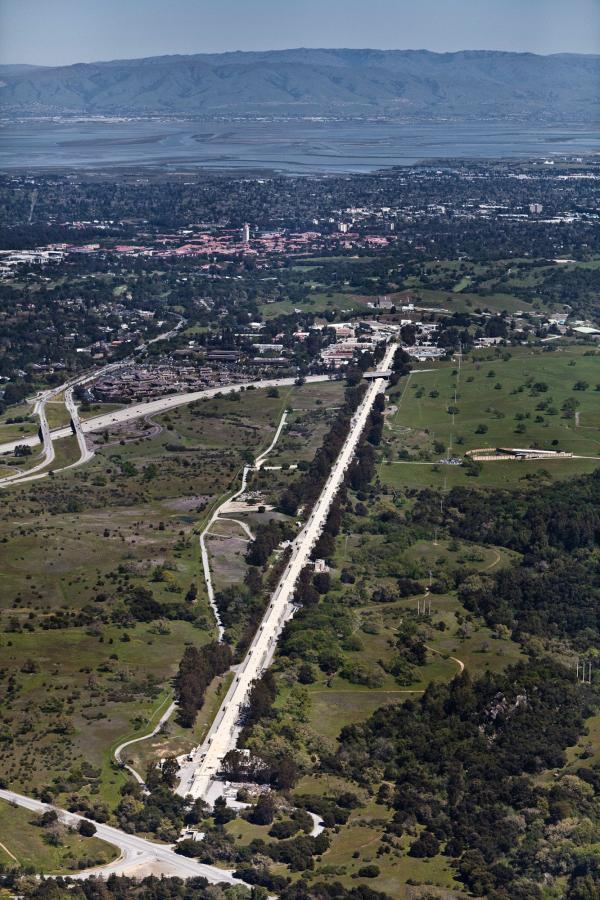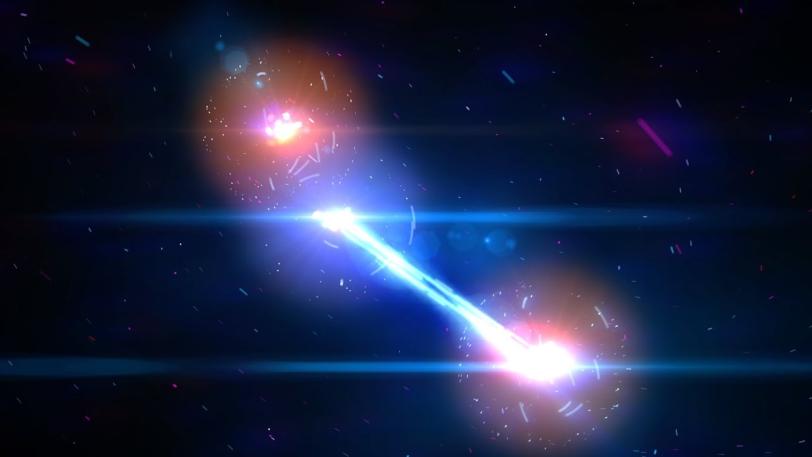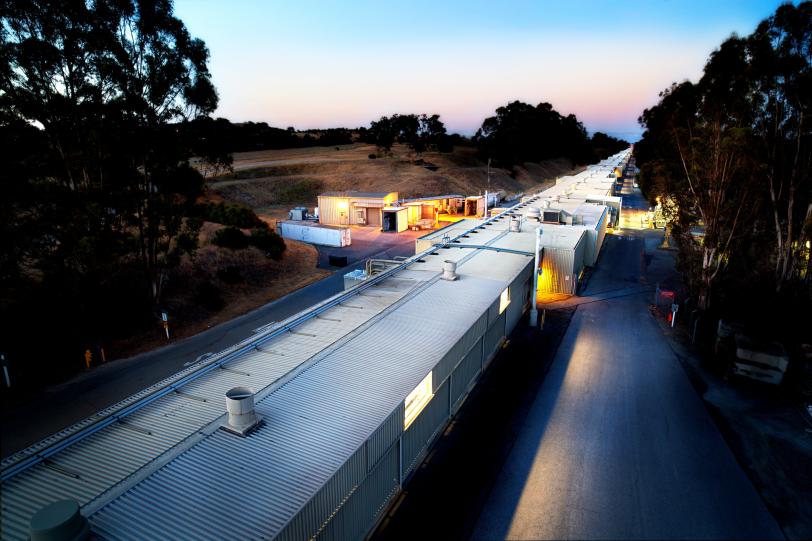SLAC’s Historic Linac Turns 50 and Gets a Makeover
The lab’s signature particle highway prepares to enter another era of transformative science as the home of the LCLS-II X-ray laser.
Since the Department of Energy’s SLAC National Accelerator Laboratory powered up its “linac” half a century ago, the 2-mile-long particle accelerator has driven a large number of successful research programs in particle physics, accelerator development and X-ray science. Now, the historic particle highway is getting a makeover that will pave the way for more groundbreaking research.
Crews have started removing equipment from the first third of the linac to make room for a next-generation X-ray laser, LCLS-II, which will feature a brand new superconducting accelerator that operates at minus 456 degrees Fahrenheit. The ultracold technology will let LCLS-II fire 8,000 times faster than its predecessor, the Linac Coherent Light Source (LCLS), and generate X-ray beams that are 10,000 times brighter. LCLS is a DOE Office of Science User Facility.
“As SLAC’s engine for discovery for the past 50 years, the linac has served a new mission every time the lab reinvented itself,” says Lia Merminga, who heads SLAC’s Accelerator Directorate. “Replacing part of the accelerator with a superconducting one is yet another historic juncture. It’s the beginning of a new era, with decades of revolutionary new science ahead of us.”
LCLS-II will operate in parallel with LCLS, which will continue to occupy the last third of the original copper linac. The accelerator’s mid-section will stay unchanged, too, and is planned to soon deliver particle beams to another proposed facility, FACET-II, for developing next-generation particle accelerator technologies.
SLAC’s 2-mile-long linac
Aerial view of SLAC’s 2-mile-long linac. The longest linear accelerator ever built, it produced its first particle beams in 1966 and has been the lab’s backbone for accelerator-driven science ever since. (SLAC National Accelerator Laboratory)

50 Years of Discovery
When the linac produced its first particle beam in the early morning hours of May 21, 1966, it was the single largest civilian science project ever undertaken by the U.S. government. To this day it is the longest linear accelerator ever built.
Designed as a discovery machine for particle physics, its first four decades would see researchers shoot energetic particle beams – electrons and their antimatter siblings, positrons – either into fixed targets or at each other in groundbreaking experiments that advanced our understanding of nature’s fundamental building blocks and forces.
In 1967, Massachusetts Institute of Technology’s Jerome Friedman and Henry Kendall and SLAC’s Richard Taylor began using the linac as a gigantic electron microscope. Probing protons and neutrons with the accelerator’s electron beam, they demonstrated that those particles were made of smaller particles. The result was instrumental in the development of the quark model and was recognized with the 1990 Nobel Prize in Physics.
In 1972, the linac beams were for the first time injected into the SPEAR storage ring to produce exotic new particles in powerful electron-positron collisions. In 1974, these experiments led to the discovery of the J/psi particle, demonstrating the existence of charm quarks. Only a year later, the tau lepton – a heavyweight relative of the electron – was discovered. Both results earned SLAC researchers Nobel Prizes in Physics: Burton Richter in 1976 for the J/psi, shared with MIT’s Samuel Ting, and Martin Perl in 1995 for the tau.
From 1980 to 2008, SLAC’s collider program continued with a series of three linac-driven particle smashers. The PEP ring generated particle collisions almost four times as powerful as SPEAR. The Stanford Linear Collider (SLC) became the world’s first and only linear particle collider and was used for detailed studies of heavy particles called Z bosons. Finally, PEP-II hosted the BABAR experiment, which in 2001 discovered that B mesons and their antiparticles decay at different rates as a result of “CP violation,” the idea that matter and antimatter behave in slightly different ways.
“The linac has always been crucial for SLAC’s mission of pursuing large-scale, multidisciplinary research of national importance,” says Richter, who directed the lab from 1984 to 1999. “For all these years, the pursuit of this mission has relied on people with a desire to advance science, a view of what might be possible and new ideas that may have seemed relatively crazy at the time they were brought forward.”
This spirit has not only driven research in high-energy physics, but has also opened up completely different scientific avenues.
In 1973, researchers began exploring an unwanted byproduct of the particle experiments at SPEAR – so-called synchrotron radiation emitted by particles as they run laps in storage rings. It turned out that this radiation had superb qualities that would revolutionize the field of X-ray science, leading to groundbreaking studies of materials, chemistry, biology, energy science and more. Today, SPEAR3 runs independently of the linac, using its own set of accelerators to inject particles into the storage ring, which is the backbone of the Stanford Synchrotron Radiation Lightsource (SSRL), a DOE Office of Science User Facility.
Another revolution in X-ray science began in 2009, when the lab began using one-third of the linac to power the world’s first hard X-ray laser, LCLS, which produces X-rays a billion times brighter than available before. Scientists use this light to catch a glimpse of nature’s atomic processes as they occur on ultrafast timescales.
Another linac-driven research focus has been the development of “plasma wakefield acceleration,” a new technology that could drastically shrink the size of future colliders and X-ray sources. At the Facility for Advanced Accelerator Experimental Tests (FACET), which used the first two-thirds of the linac until it shut down on April 4, researchers demonstrated that both electrons and positrons can “surf” waves of hot, ionized gas, or plasma, gaining up to 1,000 times higher energies over a given distance than in conventional accelerators.
“Although the linac originally aimed at the frontier of high-energy physics, it has been modified multiple times over the years to perform many other major tasks,” says John Seeman, interim deputy director for SLAC’s Accelerator Directorate. “Staff members dedicated to linac operations, maintenance and upgrades carefully work on this machine every day to keep it at its highest performance. The linac has had a spectacular past and, with the upgrade now moving forward, it will also have a spectacular future.”
Preparing for the Future
To make room for the future LCLS-II light source, the first third of the linac (sectors 0-10) needs to be completely cleared out. Crews will remove the copper structure in the accelerator tunnel below ground as well as the klystrons – microwave generators that boost particle energies along the copper racetrack – and other equipment in the building above ground.
In the first step, an 80-person work crew is now retrieving valuable equipment that can be reused in the future.
“We have a list of over 5,000 items that we want to recover, including klystrons, magnets, copper waveguides, vacuum pumps, control systems, position monitors and much more,” says SLAC’s Scott DeBarger, who is in charge of the Sector 0-10 Equipment Relocation Project. “Some of these items will serve as spares for LCLS. Others will be redeployed at LCLS-II and the proposed FACET-II. External labs and universities have also expressed interest in some of this equipment.”
After DeBarger’s team completes its retrieval operation in mid-May, the LCLS-II project team will take over and prepare the linac for an external contractor, who will begin in July to remove all remaining items, break them down and dispose of them.
By the end of 2016, the first 10 sectors of the linac will be practically empty, waiting to be filled with brand new technology that will accelerate SLAC’s research for years to come.

LCLS-II: The Next Leap for X-ray Science
This movie introduces LCLS-II, a future light source at SLAC. It will generate over 8,000 times more light pulses per second than today’s most powerful X-ray laser, LCLS, and produce an almost continuous X-ray beam that on average will be 10,000 times brighter. These unrivaled capabilities will help researchers address a number of grand challenges in science by capturing detailed snapshots of rapid processes that are beyond the reach of other light sources.
SLAC National Accelerator Laboratory
For questions or comments, contact the SLAC Office of Communications at communications@slac.stanford.edu.

About SLAC
SLAC National Accelerator Laboratory explores how the universe works at the biggest, smallest and fastest scales and invents powerful tools used by researchers around the globe. As world leaders in ultrafast science and bold explorers of the physics of the universe, we forge new ground in understanding our origins and building a healthier and more sustainable future. Our discovery and innovation help develop new materials and chemical processes and open unprecedented views of the cosmos and life’s most delicate machinery. Building on more than 60 years of visionary research, we help shape the future by advancing areas such as quantum technology, scientific computing and the development of next-generation accelerators.
SLAC is operated by Stanford University for the U.S. Department of Energy’s Office of Science. The Office of Science is the single largest supporter of basic research in the physical sciences in the United States and is working to address some of the most pressing challenges of our time.






